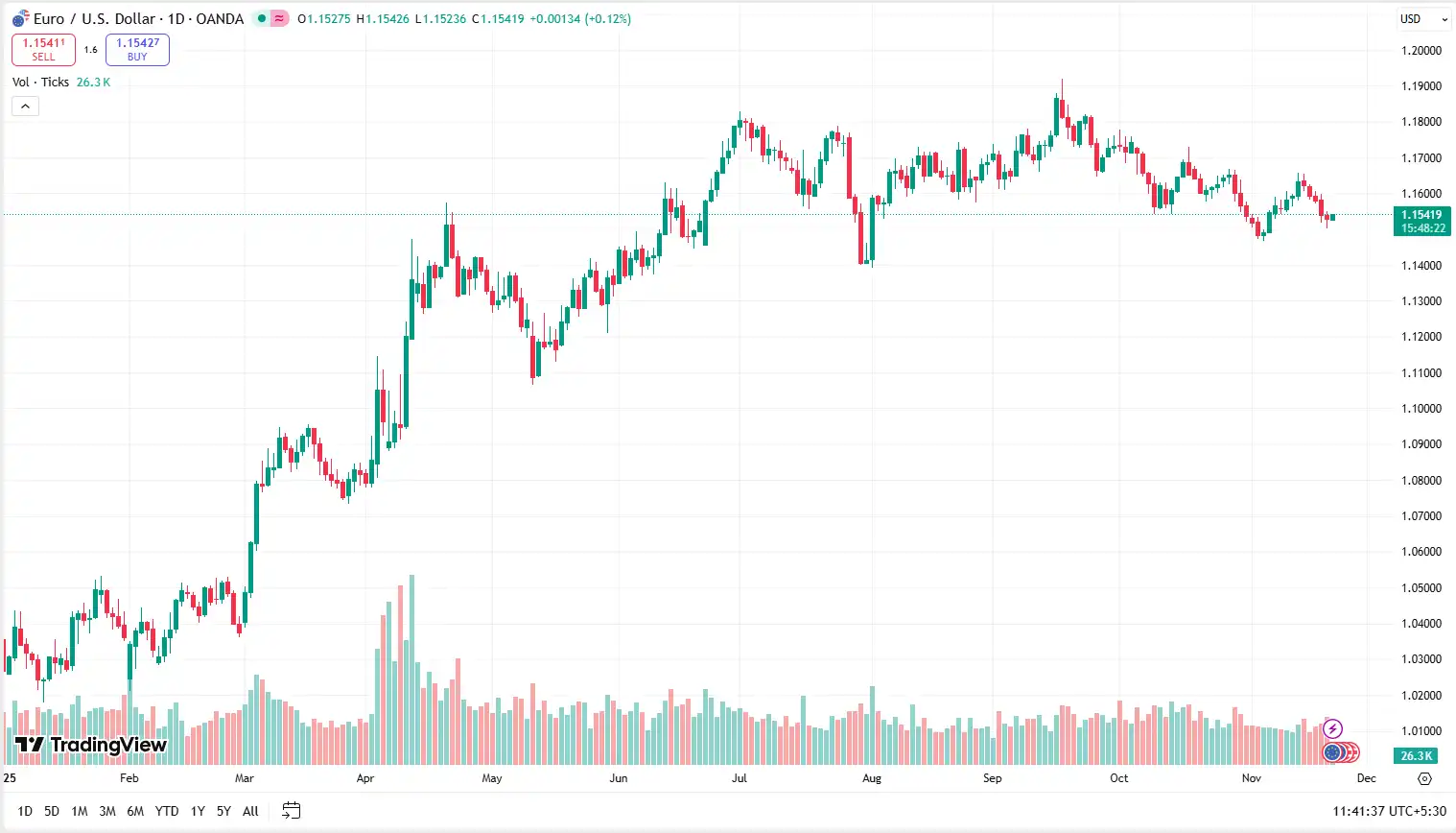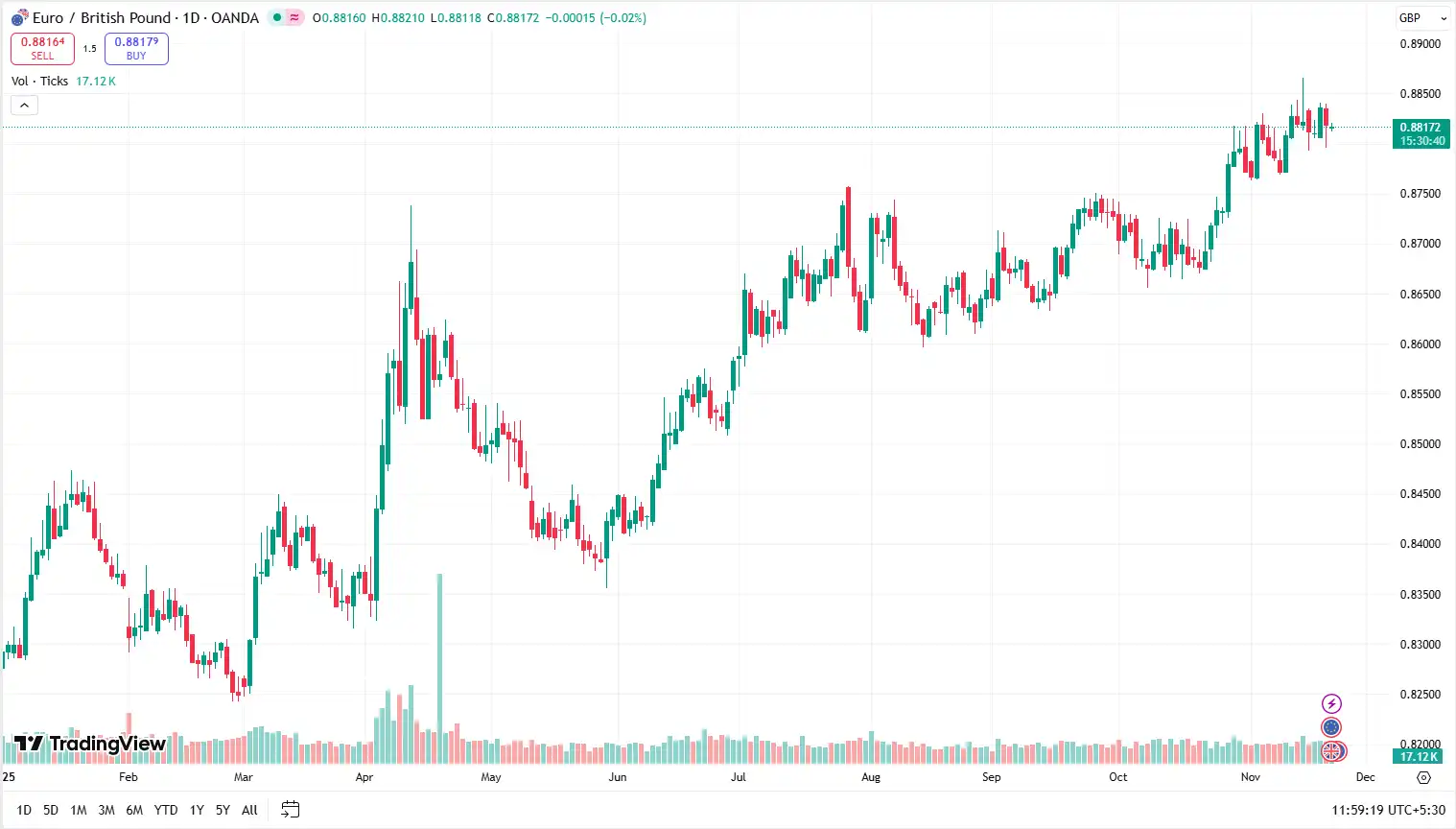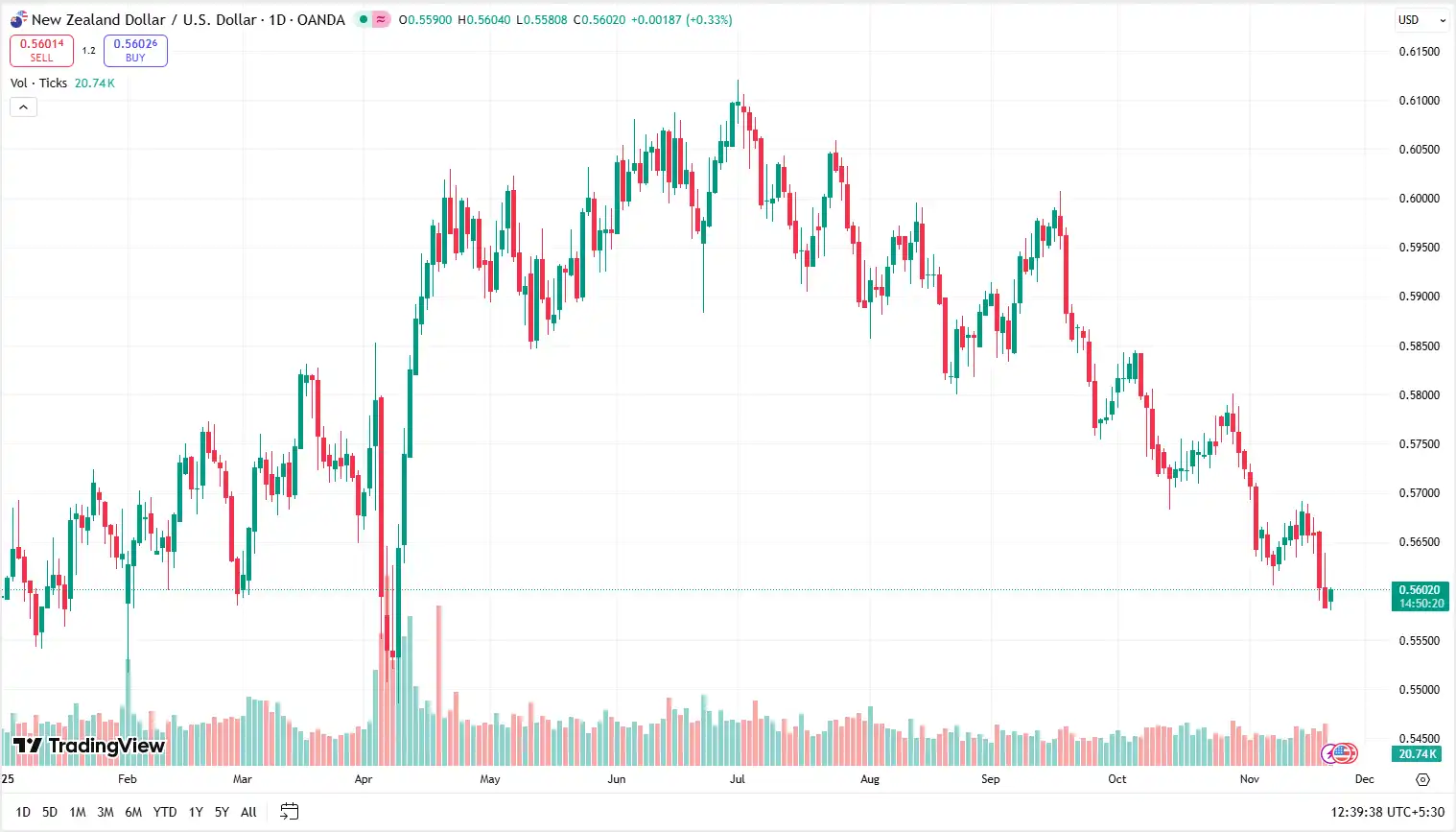The EUR/USD pair traded modestly higher near 1.1540[1] in Friday's Asian hours after a largely directionless previous session. The single currency is believed to have had mild support as the US dollar[2] weakened after a five-day rise, and the two stabilised above the mid-1.15s. Trading is stuck in a rather narrow band, and traders are waiting to see new catalysts[3] before they will make a definite direction.
Market reports[4] point out that the spotlight shifts to the release of preliminary November PMI data by Germany and the Euro zone, in general. Such figures will be used to inform assumptions on the near-term economic momentum in the bloc, especially now that the European Central Bank (ECB)[5] is broadly believed to uphold its policy positions into 2026. The remarks of ECB officials, including Ireland’s Gabriel Makhlouf[6], have strengthened the argument that the current policy environment remains suitable unless conditions change materially. This reinforces expectations that the euro will remain pressured on the downside despite the improvement in risk sentiment.
Market commentators[7] highlight that across the Atlantic, focus will turn to the US S&P Global PMI readings later in the day following the August Nonfarm Payrolls that were stronger than expected. Although the growth in payrolls increased by 119,000, significantly higher than the predictions, the increase of the unemployment rate to 4.4%[8] and stable rise in wages have slowed the dollar. The probability of a December Federal Reserve (Fed)[9] rate cut is now at 36%, higher than 30% before, which constrained the strength of the US dollar and gave short-term assistance to EUR/USD.
Analysts[10] suggest that in the future, evidence of any weakness in US activity data may continue to drag down the overall dollar picture, a trend that also has sterling implications in cross-currency flows. In the case of EUR/USD a long-lasting recovery will require subsequent data to prove stabilisation in the Eurozone situation and maintain the medium-term downside risks tied to the ECB policy inertia and remnants of the growth worry. Overall sentiment points to limited upside for the pair in the near term, and the EUR/USD exchange rate is likely to remain constrained unless clearer shifts emerge in Eurozone data or Federal Reserve expectations.

EUR/GBP Steady as Pound Faces Renewed Pressure
The EUR/GBP cross remains under mild downward pressure, trading near 0.8815[11] in Friday's early European trading hours, as the pound attempts to stabilise despite a softer macroeconomic backdrop. The price action has been relatively subdued, with the pair[12] ending the week below last week’s highs as traders reassess short-term positioning. Markets are now turning their focus to key Eurozone and UK PMI and retail sales releases, which could set the tone for near-term direction. Nevertheless, the larger spread indicates a market that is risk averse about the medium-term prospects with the recent repricing in rate expectations by the Bank of England (BoE)[13] rate limit GBP gains.
Market reports[14] indicate that the mood towards the pound has worsened with markets now pricing in a BoE rate cut at the December meeting and interest rate swaps indicating near certainty of a further cut with an almost 87% likelihood. This movement is indicative of ongoing uncertainty in the UK economy[15] as well as greater fiscal misgiving before the 26 November Autumn Budget that will likely influence future treatment in policy flexibility terms. These have assisted in curbing Sterling demands, which provides some form of backdrop to EUR/GBP despite the duo approaching the downwards intraday.
Market commentators[16] attribute this to the fact that the near-term market can be determined by the upcoming UK Retail Sales and PMI data with any negative surprises playing up the fears of poor domestic demand. The weaker US macro indicators[17] released this week have also indirectly pressured the Pound by undermining global risk appetite. Investors are placing greater emphasis on the loss of economy-wide momentum, leaving risk-sensitive currencies increasingly vulnerable. With the US market set to release additional labour and housing figures[18] today, the risk-sensitive currencies like GBP may be left exposed as the figures will disclose their further loss of momentum.
Meanwhile, ECB[19] officials are cautious in their commentary and forecasting a stable policy until 2026 is a stabilising influence on the euro. Whereas EUR/GBP can remain pressured in the very near future the structural headwinds of the UK economy imply that risks are skewed to the upside as the cross unwinds short-term positioning once more. Given these dynamics, the EUR/GBP exchange rate is likely to stay supported as UK-focused risks continue to outweigh near-term euro softness.

GBP/USD Drifts Amid Diverging Policy Outlook
GBP/USD edged higher trading near 1.3090[20] in Friday's early European session as traders reassessed the short-term outlook ahead of key UK and US data releases. Although the pound has seen modest support following a brief normalisation in broader risk sentiment, upside traction has remained limited. Rising expectations that the BoE[21] will deliver its first rate cut in December continue to cap the currency’s momentum. The weaker signs of UK activity[22] and diminishing price pressures remain in place to set the macro context, leaving sterling exposed to occasional corrective rebound.
Market reports[23] note that the latest UK data has reinforced a dovish shift in market pricing. Weak CPI, sluggish GDP growth, and disappointing industrial output have fuelled speculation that the BoE is preparing to begin its easing cycle. This is contrary to the US viewpoint where ambivalent yet strong labour statistics and future US PMI statistics later on Friday may affect the dollar demand. Even the slightest indication of weakening US action can curtail downside in GBP/USD[24] in the short-term, although the overall policy divergence remains to place the pound at a disadvantage going into year-end.
Technically, analysts[25] indicate that GBP/USD is trading between 1.3091 and below the falling 100-day EMA at 1.3323, which still restrains recovery efforts and is still keeping a larger bearish framework. The Relative Strength Index (RSI)[26] of 39 indicates that the momentum is quiet without oversold indicators and that the sellers are in charge unless the duo manages to close daily above the 100-day EMA. Selling interest on approach to resistance levels, until then, is likely to be met by rallies.
Market commentators[27] point out that the Bollinger Bands have narrowed meaning that volatility has diminished and the consolidation phase is underway. Price is below the 20 day midline at 1.3148 and risk is skewed to the lower band at 1.3005 unless buyers reclaim the mid band at 1.3148. Although the short-term statistics of the US may provide a short-term relief, the medium-term threats facing GBP/USD remain skewed on the downside as the BoE gears up to reduce the policy. Given the current policy divergence and weakening UK outlook, the GBP/USD exchange rate remains vulnerable to further downside pressure.

NZD/USD Edges Higher Amid Cautious Sentiment
The NZD/USD pair edged higher trading near 0.5600[28] in Friday's early Asian session. The small rebound is believed to be the result of the low price volatility as the market players are taking into consideration the possibility of additional easing of monetary policy by the Reserve Bank of New Zealand (RBNZ)[29]. Although the pair has benefited in the short term by the light consolidation of the US dollar[30], the momentum in the upside is limited before the next policy announcement, leaving traders on the guard around the current positions.
Market commentators[31] note that sentiment toward the New Zealand Dollar remains weak following last month’s unexpected 50-basis-point rate reduction. They add that markets are strongly positioned for a further 25-basis-point cut at the November meeting. A recent financial stability report by RBNZ[32] has emphasized on the underperformance of the economy and the high level of global uncertainty which validates the dovish bias of the central bank. As Westpac[33] predicts a decrease in the rate path that RBNZ has projected, the outlook of the medium-run currency of the New Zealand dollar will be constrained with the limited room to recover the currency in a lasting way.
Market reports[34] point out that the dollar has also found some support in October in the US, with the non-farm payrolls increasing by 119,000 against expectations of 50,000. The labour market data, though the rate of unemployment rose to 4.4, has helped regain some confidence in the US dollar[35] capping gains in the kiwi. This economic momentum still favours the greenback, especially with the Fed still under data-dependent posture and the RBNZ sliding towards additional easing.
Analysts[36] indicate that in the near-term, the focus is on the upcoming US S&P Global PMI readings and the University of Michigan Consumer Sentiment Index. Any unexpected negative activity or sentiment will give the US dollar a checkpoint and short-lived NZD/USD. Nevertheless, since the outlook of the rate in New Zealand[37] is strongly tilted to the downside, medium-term risks will be biased against the pair even though it experiences occasional rebounds. Given this backdrop, the NZD/USD exchange rate is likely to remain pressured as divergent policy trajectories continue to favour the US dollar.

Stay Ahead in the Currency Game
Whether you're a daily FX trader or handle international transactions regularly, our 'Currency Pulse' newsletter delivers the news you need to make more informed decisions. Receive concise updates and in-depth insights directly in your LinkedIn feed.
Subscribe to 'Currency Pulse' now and never miss a beat in the currency markets!
Ready to act on today’s insights? Get a free quote or give us a call on: +44 (0)20 7740 0000 to connect with a dedicated portfolio manager for tailored support.
Important Disclaimer: This blog is for informational purposes only and should not be considered financial advice. Currency Solutions does not take into account the investment objectives, financial situation, or specific needs of any individual readers. We do not endorse or recommend any specific financial strategies, products, or services mentioned in this content. All information is provided “as is” without any representations or warranties, express or implied, regarding its accuracy, completeness, or timeliness.




